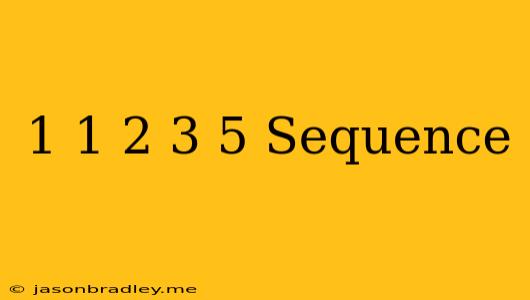The Enigmatic 1 1 2 3 5 Sequence: Unraveling the Mystery
The sequence 1 1 2 3 5, often referred to as the Fibonacci sequence, is a fascinating mathematical concept that has captivated mathematicians and enthusiasts for centuries. While it might appear simple at first glance, this sequence holds a surprising depth and intricate connections to various fields.
The Foundation of Fibonacci
The Fibonacci sequence is named after Leonardo Pisano, better known as Fibonacci, an Italian mathematician who introduced it in his 1202 book "Liber Abaci." The sequence is defined by a simple rule: each number is the sum of the two preceding numbers.
Here's how it unfolds:
- 1, 1, 2, 3, 5, 8, 13, 21, 34, 55...
Starting with 1 and 1, each subsequent number is calculated by adding the two numbers before it. For instance, 2 is the sum of 1 and 1, 3 is the sum of 1 and 2, 5 is the sum of 2 and 3, and so on.
Beyond Numbers: The Beauty of Fibonacci
The Fibonacci sequence transcends the realm of mere arithmetic and reveals itself in various aspects of nature and science. Its presence can be observed in:
- Plant growth: The arrangement of leaves on a stem, the spiral patterns in pinecones, and the branching of trees often exhibit Fibonacci ratios.
- Animal anatomy: The number of spirals in a nautilus shell, the branching patterns in veins, and the distribution of scales on a pineapple all align with the Fibonacci sequence.
- Art and architecture: The golden ratio, a mathematical concept closely linked to the Fibonacci sequence, has been incorporated into works of art and architecture throughout history, contributing to their harmonious and aesthetically pleasing proportions.
The Golden Ratio: A Divine Connection
The golden ratio (approximately 1.618), denoted by the Greek letter phi (φ), is intimately connected to the Fibonacci sequence. As the Fibonacci sequence progresses, the ratio between consecutive terms approaches the golden ratio. This ratio, also known as the divine proportion, is observed in numerous natural phenomena and is often associated with beauty and balance.
Applications in Computing and Programming
The Fibonacci sequence finds practical applications in computer science, particularly in algorithms and programming. Its efficient and recursive nature makes it useful for tasks involving:
- Data structures: The Fibonacci sequence is used in the construction of certain data structures, such as Fibonacci heaps.
- Searching and sorting: The Fibonacci search technique offers an efficient way to search for elements in sorted data.
- Optimization: The Fibonacci sequence can be incorporated into optimization algorithms, helping to find optimal solutions for various problems.
Conclusion
The 1 1 2 3 5 sequence, or the Fibonacci sequence, is more than just a series of numbers. It embodies a fundamental mathematical principle that permeates nature, art, and science. Its elegant simplicity and unexpected connections to various domains continue to fascinate mathematicians and researchers, offering a testament to the beauty and interconnectedness of the universe.
